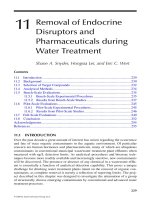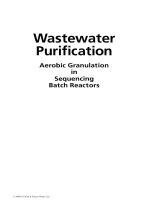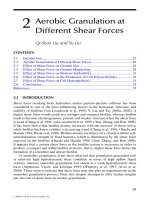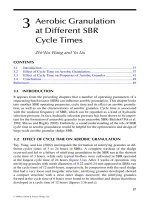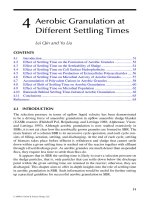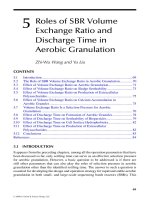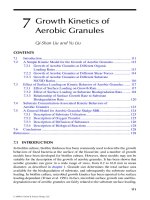Wastewater Purification: Aerobic Granulation in Sequencing Batch Reactors - Chapter 11 ppt
Bạn đang xem bản rút gọn của tài liệu. Xem và tải ngay bản đầy đủ của tài liệu tại đây (664.25 KB, 14 trang )
195
11
Internal Structure of
Aerobic Granules
Zhi-Wu Wang and Yu Liu
CONTENTS
11.1 Introduction 195
11.2 Internal Structure of Aerobic Granules 195
11.2.1 Heterogeneous Structure of Aerobic Granules 195
11.2.2 Porosity of Aerobic Granules 196
11.2.3 Size-Dependent Internal Structure of Aerobic Granules 197
11.2.4 Structure Change of Aerobic Granules during Starvation 198
11.3 Biomass Distribution in Aerobic Granules 199
11.4 PS Distribution in Aerobic Granules 201
11.5 Distribution of Cell Surface Hydrophobicity in Aerobic Granules 205
11.6 Diffusion-Related Structure of Aerobic Granules 206
11.7 Conclusions 207
References 207
11.1 INTRODUCTION
Theuniquefeaturesofaerobicgranules,asdifferentfrombiooc,aretheirdense
and spherical three-dimensional structure. A good perception into the conformation
of this granular structure, in comparison with that of bioocs, will certainly help
deepencurrentunderstandingofthemechanismofaerobicgranulation,aswellasits
structural stability. As presented in chapter 10, an aerobic granule is mainly build up
by microbial cells embedded in their excreted extracellular polysaccharides (PS), that
is,PSplayacementingroleinconnectingindividualcellsintothethree-dimensional
structure of an aerobic granule. Moreover, the PS characteristics also inuence the
surfacepropertyofmicrobialcells(seechapter9).Itseemscertainthatthestructure
of an aerobic granule is essentially determined by the distributions and properties of
its construction blocks, namely the microbial cells and PS. Thus, this chapter offers
up-to-date information about the internal structure of aerobic granules in terms of
the distributions of the microbial cells, PS, and cell surface hydrophobicity.
11.2 INTERNAL STRUCTURE OF AEROBIC GRANULES
11.2.1 H
ETEROGENEOUS STRUCTURE OF AEROBIC GRANULES
Anaerobicgranulecultivatedinanacetate-fedsequencingbatchreactor(SBR)was
sliced and its internal structure was visualized by imagine analysis technique (Wang,
53671_C011.indd 195 10/29/07 7:33:51 AM
© 2008 by Taylor & Francis Group, LLC
© 2008 by Taylor & Francis Group, LLC
196 Wastewater Purification
Liu,andTay2005).Itwasfound,asshowningure11.1,thattheinternalstructure
of an aerobic granule consisted basically of an opaque outer layer and a relatively
transparentinnercore.Theopaqueouterlayerhadadepthofabout800µmfromthe
granulesurfacedownwards,andthegranulecenterlookedtransparent.
11.2.2 POROSITY OF AEROBIC GRANULES
Porosity of biolm or anaerobic granules can facilitate nutrient transfer (Alphenaar
etal.1992;ZhangandBishop1994).J.H.Tayetal.(2003)used0.1-μmuorescence
beadstostudytheporosityofaerobicgranules,andfoundthattheporosityexisted
throughouttheaerobicgranulestructure,butitpeakedat150and200μmbeneath
thesurfaceofaerobicgranuleswithsizesof0.55and1.0mm,respectively.Never
-
theless,thetotalporouszonesdecreasedwithincreasinggranulediameter,onaunit
volumebasis(J.H.Tayetal.2003).
Thezigzagporechannelwasfoundtowindthroughthegranulematrixmadeup
by PS, that is, the porosity should be correlated to the richness of PS (Zheng and Yu
2007). A study by size-exclusion chromatography method revealed that the PS con
-
tent increased, but the porosity decreased with the granule diameter, for example the
poresizeofanaerobicgranulewithasizeof0.2to0.6mmwasnearlyseventimes
Thepossiblecloggingcausedbyover-producedPSwasthusconsideredtoberespon
-
sible for the reduced porosity in large-sized aerobic granule. In addition, Chiu et al.
(2006)alsoreportedthatalargegranulewouldhaveahighporosity,evidencedby
an enhanced oxygen diffusivity, with an increase of granule size, for example, diffu
-
sion coefcients of oxygen were measured as 1.24 × 10
–9
to2.28×10
–9
m
2
s
–1
as the
sizeofacetate-fedaerobicgranulesincreasedfrom1.28to2.50mm,andasimilar
phenomenon was also observed in phenol-fed aerobic granules. Based on these
(a) (b)
FIGURE 11.1 Cross-sectionview(400μmthickness)oftheaerobicgranuleinbrighteld
(a) and dark eld (b) visualization modes. Scale bar, 500 μm. (From Wang, Z W., Liu, Y., and
Tay, J H. 2005. Appl Microbiol Biotechnol 60:687–695.Withpermission.)
53671_C011.indd 196 10/29/07 7:33:53 AM
© 2008 by Taylor & Francis Group, LLC
© 2008 by Taylor & Francis Group, LLC
biggerthanthatofaerobicgranuleswithalargersizeof0.9to1.5mm (gure11.2).
Internal Structure of Aerobic Granules 197
controversialndings,itisdifculttoconcludethatgranuleporosityisdependent
on its particle size.
11.2.3 SIZE-DEPENDENT INTERNAL STRUCTURE OF AEROBIC GRANULES
Toinvestigatetheinternalstructureofaerobicgranuleswithvarioussizes,mature
aerobicgranuleswithameandiameterof0.8to3.0mmwereslicedandfurthervisu-
alized by image analyzer (Wang, Liu, and Tay 2005). The image analysis revealed
thatthesmallaerobicgranulewithadiameterof0.8mmhadanearlyhomogenous
structure,whereaslargeraerobicgranuleswithadiameterof3.0mmexhibiteda
layeredinternalstructureinwhichaclearshellandcorecouldbedistinguished
(gure 11.3). Furthermore, the granule structure seems to evolve with the growth of
theaerobicgranuleinsize,thatis,atransitionfromahomogenoustoheterogeneous
structure was observed with increase in the granule size (gure 11.3). As can be seen
in gure 11.3, this is also evidenced by the gradually brightened transparent space
fromthegranuleshelltoitscenterwithincreasedgranulesize.
Asdiscussedinchapter8,theoccurrenceofdiffusionlimitationisassociated
withthesizeoftheaerobicgranule.Themodelsimulationshowsthatdissolved
oxygen(DO)wouldbecomealimitingfactorformicrobialgrowthatbulkCOD
concentration greater than 465 mg L
–1
,andthesolubleCODcanpenetratethrough-
outtheaerobicgranulewithadiametersmallerthan0.8mm,whichexhibited
limitation would be encountered in large-sized aerobic granules of 1.0 to 1.5 mm
(chapter 8). These results seem to indicate that the observed layered structure of
large-sizedaerobicgranuleswouldresultfromdiffusionlimitationbecauseonly
thosemicroorganismslivingintheshelloftheaerobicgranuleareaccessibleto
DO and substrate.
Range of Granule Size (mm)
0.2-0.6 0.6-0.9 0.9-1.5
Excluded Molecular Mass (Da)
0
20 × 10
3
40 × 10
3
60 × 10
3
80 × 10
3
100 × 10
3
120 × 10
3
140 × 10
3
160 × 10
3
FIGURE 11.2 The penetrable molecular mass for different sized aerobic granules. (Data
from Zheng, Y M. and Yu, H Q. 2007. Water Res 41: 39–46.)
53671_C011.indd 197 10/29/07 7:33:54 AM
© 2008 by Taylor & Francis Group, LLC
© 2008 by Taylor & Francis Group, LLC
ahomogeneousstructure(gure11.1a).Ontheotherhand,severeDOdiffusion
198 Wastewater Purification
11.2.4 STRUCTURE CHANGE OF AEROBIC GRANULES DURING STARVATION
Fresh aerobic granules were starved under aerobic condition without addition of
carbonandnutrientsourcesfor20days.Changesingranulestructurebeforeandafter
the20-daystarvationareshowningure11.4.Comparedtothefreshaerobicgranule
(gure 11.4a), the starved granule became more transparent. A transmittance analysis
acrosstheintactgranuleindicatesthattheopaquecoreofthefreshaerobicgranulehad
become highly light permeable (gure 11.5), and the sliced, starved granule clearly
(a) (b)
FIGURE 11.4 Aviewofanaerobicgranulebefore(a)andafter(b)long-termstarvation;
scalebar:300μm.(FromWang,Z W.,Liu,Y.,andTay,J H.2005.Appl Microbiol Biotechnol
60:687–695.Withpermission.)
(a) (b)
(c) (d)
FIGURE 11.3 Internalstructureofslicedaerobicgranuleswithdiametersof0.8mm(a),
1.3mm(b),2.0mm(c),and3.0mm(d);scalebars:0.5mm.
53671_C011.indd 198 10/29/07 7:33:56 AM
© 2008 by Taylor & Francis Group, LLC
© 2008 by Taylor & Francis Group, LLC
Internal Structure of Aerobic Granules 199
showedahollowstructureeventhoughitsoutershellstillremainedintact (gure11.6).
These observations seem to suggest that the biomass present in the granule shell
would not be taken up by bacteria over starvation, while the biomass located in the
core of the aerobic granule can be biodegraded under the starvation condition.
11.3 BIOMASS DISTRIBUTION IN AEROBIC GRANULES
The heterogeneous structure of aerobic granules indicates an uneven distribution of
biomass.Chen,Lee,andTay(2007)useduorescentdyestovisualizethemicrobial
FIGURE 11.5 Light transmittal proles across intact aerobic granule before (black) and
after (gray) long-term starvation (arrow indicates granule center). (From Wang, Z W., Liu, Y.,
and Tay, J H. 2005. Appl Microbiol Biotechnol 60:687–695.Withpermission.)
FIGURE 11.6 The hollow structure of the starved aerobic granule. (From Wang, Z W.,
Liu, Y., and Tay, J H. 2005. Appl Microbiol Biotechnol 60:687–695.Withpermission.)
53671_C011.indd 199 10/29/07 7:33:58 AM
© 2008 by Taylor & Francis Group, LLC
© 2008 by Taylor & Francis Group, LLC
200 Wastewater Purification
cellsdistributionbymeansofconfocallaserscanningmicroscopy(CLSM),and
foundthatlivecellswereconcentratedinthegranuleshell,indicatedbyared
uorescence emitted from Syto 63 that stained nucleic acid (gure 11.7). In contrast,
the uorescence from the granule core is rather weak, indicating a limiting number
oflivebacteriainthecorepartoftheaerobicgranule.Similarobservationwasalso
reportedbyTohetal.(2003)andMcSwainetal.(2005).InthestudybyMcSwainet
al.(2005),theSyto63uorescencepeakedatadepthof100μmbeneaththegranule
surfaceandthegranulecorepartwasalmostuorescencefree.Detaileddistribution
ofliveanddeadcellsinsidetheaerobicgranulewasinvestigatedbyJ.H.Tayetal.
Itwasdemonstratedthatmostlivebacteria,includingnitriers,onlyexistedinthe
granule outer shell layer where they were within the reach of mass diffusion, while
deadcellsandanaerobesweremainlydetectedatthecoreoftheaerobicgranule,
indicating an uneven microbial distribution in aerobic granules that should result
from diffusion limitation (gure 11.7).
Optical density (OD) has been commonly used to quantify the biomass concen
-
tration,thatis,ahighODiscorrelatedtoahighbiomassconcentrationordensity
in suspended and biolm cultures (Gaudy and Gaudy 1980). Figure 11.8 exhibits the
ODprolemeasuredacrossthecrosssectionofanaerobicgranule.Itwasfoundthat
theODinthegranulecenterwasclosetozero,indicatingaverylowbiomassdensity
or a loose microbial structure at the core. In contrast, the peak OD was observed
intheouterlayeroftheaerobicgranule,whichwouldresultfromahighbiomass
density or a compact microbial structure (Wang, Liu, and Tay 2005). To conrm
theseobservations,veaerobicgranules,namelyNo.1to5,wereslicedandthe
respectivemassdensityoftheoutershelllayerandtheinnercorepartwasmeasured.
It was found that the mass density of the outer layer of the granule was indeed much
higher than that of the core part (gure 11.9). In fact, J. H. Tay et al. (2002) reported
asimilarbiomassdistributioninaerobicgranules.Asdiscussedearlier,massdiffu
-
sionlimitationwouldberesponsiblefortheobserveddensesurfacelayerandloose
FIGURE 11.7 Cell distribution in aerobic granules, Syto 63 (red)-stained nucleic acid.
(FromChen,M.Y.,Lee,D.J.,andTay,J.H.2007.Appl Microbiol Biotechnol 73: 1463–1469.
With permission.)
53671_C011.indd 200 10/29/07 7:33:59 AM
© 2008 by Taylor & Francis Group, LLC
© 2008 by Taylor & Francis Group, LLC
Internal Structure of Aerobic Granules 201
inner core of aerobic granules, that is, the unbalanced biomass distribution is due to
thediffusionlimitationinsidetheaerobicgranule.
11.4 PS DISTRIBUTION IN AEROBIC GRANULES
Calcouorwhiteisacommonlyuseduorescentdyeforlabelingbeta-linkedpoly-
saccharides (PS) (deBeer et al. 1996). The beta-linked polysaccharides are believed
toserveasthebackboneofthebiolmstructure(Sutherland2001).Tolocalizebeta-
linked polysaccharides in an aerobic granule, the aerobic granule was sliced and its
"
!
FIGURE 11.8 TheODprolethroughthegranulecrosssection(arrowindicatesgranule
center).(DatafromWang,Z W.,Liu,Y.,andTay,J H.2005.Appl Microbiol Biotechnol
60: 687–695.)
Mass Density Ratio of Shell to Core
0.0
0.2
0.4
0.6
0.8
1.0
1.2
1.4
Granule No. 1
Granule No. 2
Granule No. 3
Granule No. 4
Granule No. 5
FIGURE 11.9 Biomassdensityratiosofshelllayertocorepartofaerobicgranules.(Data
fromWang,Z W.,Liu,Y.,andTay,J H.2005.Appl Microbiol Biotechnol 60: 687–695.)
53671_C011.indd 201 10/29/07 7:34:01 AM
© 2008 by Taylor & Francis Group, LLC
© 2008 by Taylor & Francis Group, LLC
202 Wastewater Purification
crosssectionwasstainedwithcalcouor(Wang,Liu,andTay2005).Inafreshgranule,
theuorescentdyewasattachedmainlytotheoutershellofthegranule,whilevery
weak uorescence was detected at the center of the aerobic granule (gure 11.10b).
Theuorescenceintensityprolemeasuredalongthedirectionofthegranuleradius
furthershowedthatmostcalcouorwhite-stainedPSwassituatedintheoutershell
ofthegranule,withadepthof400µmbelowthegranulesurface(gure11.11).These
ndingsimplythatthebeta-linkedPSarelocatedmainlyintheoutershellofthe
granule.Infact,asimilardistributionofbeta-linkedPSwasalsoobservedinanaerobic
granules;themajorityofthecalcouorwhite-stainedPSwasfoundinthetop40μm
fromthesurfaceoftheanaerobicgranule(deBeeretal.1996).
Chen, Lee, and Tay (2007) used three different uorescence dyes, namely ConA
andcalcouorwhiteandFITC,tolabelthealpha-,beta-linkedPSandalsoprotein
(a) (b)
FIGURE 11.10 Microscopic view of sectioned aerobic granule cross section before (a) and
after(b)calcouorwhitestaining;scale:100μm.(FromWang,Z W.,Liu,Y.,andTay,J H.
2005. Appl Microbiol Biotechnol 60:687–695.Withpermission.)
FIGURE 11.11 Proleoftheuorescenceintensityfromthesurfacetothecenterofan
aerobicgranule.(DatafromWang,Z W.,Liu,Y.,andTay,J H.2005.Appl Microbiol
Biotechnol 60: 687–695.)
53671_C011.indd 202 10/29/07 7:34:04 AM
© 2008 by Taylor & Francis Group, LLC
© 2008 by Taylor & Francis Group, LLC
Internal Structure of Aerobic Granules 203
(PN). The observations by CLSM revealed that the alpha-linked PS was distributed
mainly on the granule shell, while the granule core was almost alpha-linked PS
free (gure 11.12a). A similar distribution of alpha-linked PS was also reported by
McSwainetal.(2005).However,thestudybyChen,Lee,andTay(2007)showeda
differentdistributionofthebeta-linkedPSfromwhatwasfoundingure11.10,that
is, the beta-linked PS not only appeared on the granule shell, but also was concen
-
tratedinthegranulecore.Moreover,auorescentemptylayerwasfoundinbetween
the granule shell and core (gure 11.12b). As for PN, a random distribution pattern
wasfoundalongthegranuleradiumdirection(gure11.12c).
ToquantifythePSdistributioninthelayeredaerobicgranule,Wang,Liu,and
Tay(2005)measuredthePScontentsinthegranuleshellaswellasinthegranule
core, for example, the PS present in the granule shell only accounts for one-fth of
the PS found in the granule core. Such a nding implies that those gel-like substances
observed in the granule center (gure 11.1) could be attributed to PS. As discussed
(a) (b)
(c)
FIGURE 11.12 FluorescenceviewedongranulecrosssectionbystainingwithConAfor
alpha-linkedPS(a);calcouorwhiteforbeta-linkedPS(b);andFITCforprotein(c).Scale
bar:200μm.(FromChen,M.Y.,Lee,D.J.,andTay,J.H.2007.Appl Microbiol Biotechnol
73:1463–1469.Withpermission.)
53671_C011.indd 203 10/29/07 7:34:06 AM
© 2008 by Taylor & Francis Group, LLC
© 2008 by Taylor & Francis Group, LLC
core(gure11.13).MostPSintheaerobicgranulewascentralizedatthegranule
53671_C011.indd 204 10/29/07 7:34:07 AM
© 2008 by Taylor & Francis Group, LLC
© 2008 by Taylor & Francis Group, LLC
204 Wastewater Purification
earlier, the PS present in the granule core is basically biodegradable. In view of the
total amount of PS determined in the aerobic granule, it appears that the alpha- or
beta-linked PS may not be the dominate constitution of EPS in aerobic granules.
EPS is the extracellular products synthesized by microbial cells. As shown
earlier, the cell distribution would be granule size-dependent due to diffusion limita
-
tion. Hence, the distribution of PS would also be related to the size of the aerobic
granule. McSwain et al. (2005) investigated the PS distribution in small and large
aerobic granules with a respective size of 350 μm and 800 μm. The observation by
CLSM revealed that in the small bioparticle, both PS and PN were concentrated at
the core (gure 11.14a). For the large-sized bioparticle, PS and microbial cells turned
out to be only centralized on the granule outer shell, with a random distribution of
PN (gure 11.14b). Similar EPS distributions have been reported in anaerobic bio
-
oc and granule, that is, calcouor-stained PS was mainly distributed on the outer
Shell Core
PS Content (mg cm
–3
)
0
50
100
150
200
250
fIGure 11.13 Distribution of PS in granule shell and core. (Data from Wang, Z W.,
Liu, Y., and Tay, J H. 2005. Appl Microbiol Biotechnol 60: 687–695.)
(a) (b)
100 µm
fIGure 11.14 Fluorescence by Syto 63 for cells (bright), ConA for polysaccharides (gray),
and FITC for protein (
white) in biooc (a) and aerobic granule (b). (From McSwain, B. S.
et al. 2005. Appl Environ Microbiol 71: 1051–1057. With permission.)
Internal Structure of Aerobic Granules 205
shellofanaerobicgranules,butappearedtobeconcentratedinthecenterofbiooc
(deBeer et al. 1996). It has been recognized that the partial anaerobic condition,
like those beneath the granule shell, is able to trigger EPS overproduction (Gamar-
Nourani, Blondeau, and Simonet 1998). This provides a plausible explanation for the
abundantEPSobservedinthegranulecore(gure11.13).
11.5 DISTRIBUTION OF CELL SURFACE HYDROPHOBICITY IN
AEROBIC GRANULES
Cell surface hydrophobicity has been regarded as a trigger of aerobic granulation
(chapter9).Basically,cellhydrophobicityhelpsreducethesurfaceenergyofindivid
-
ualcellssoastoovercomethedispersivepolarforcefromwater,andfurtherpromote
cell-to-cell co-aggregation. After the formation of the aerobic granule, the primary
triggerfunctionofcellsurfacehydrophobicitymaybecomesecondarilyimportant,
butcellsurfacehydrophobicitymaycontinuetoplayapartinthestabilityofthe
aerobic granule structure. Unfortunately, little information is presently available
aboutthedistributionofcellsurfacehydrophobicityinmatureaerobicgranules.
To give some insights into the cell hydrophobicity distribution in aerobic gran
-
ules, Wang, Liu, and Tay (2005) separated the granule outer shell from its inner
core,andtheirrespectivecellsurfacehydrophobicitywasthendeterminedbythe
methodofmicrobialattachmenttosolvent(MATS).Asshowningure11.15,the
cellsurfacehydrophobicityofmicroorganismsonthegranuleoutershellwasalmost
twofold higher than that at the granule core. This provides indirect evidence that the
gel-like substances found in the granule core (gure 11.1) is relatively hydrophilic as
compared to the granule shell.
Solidevidenceshowsthatcellsurfacehydrophobicityiscorrelatedtothetype
and properties of EPS (chapter 10). In the three-dimensional structure of aerobic
Sell Core
Cell Surface Hydrophobicity (%)
0
10
20
30
40
50
60
70
FIGURE 11.15 Cellhydrophobicitydistributionsintheshellandcorepartsofanaerobic
granule. (Data from Wang, Z W., Liu, Y., and Tay, J H. 2005. Appl Microbiol Biotechnol
60: 687–695.)
53671_C011.indd 205 10/29/07 7:34:08 AM
© 2008 by Taylor & Francis Group, LLC
© 2008 by Taylor & Francis Group, LLC
206 Wastewater Purification
granules,onlycellsinthegranuleshellhavedirectcontactwiththebulkliquid,thus
it is reasonable to consider that a hydrophobic granule shell is necessary to keep the
integrityoftheaerobicgranuleandfurthertopreventthegranulestructurefrom
dissolution into bulk liquid. This would partially illustrate why the granule shell-
associated microorganisms favor production of relatively more hydrophobic EPS.
Thealpha-andbeta-linkedEPShavebeenfoundonthegranuleshelllayer
(gures11.10,11.12,and11.14).Infact,increasedproductionofalpha-linkedEPS
can improve cell surface hydrophobicity (Lawman and Bleiweis 1991), and insoluble
beta-linkedEPSwasalsoreportedtoserveasthebackboneofbiolmstructure
(Sutherland 2001). For the granule core-associated EPS, the hydrophobic property
starvation, most of the granule-core-associated EPS disappeared, that is, those
less hydrophobic EPS are highly biodegradable as compared to the shell EPS. In
general, only soluble EPS is biodegradable, while insoluble or bound EPS should be
nonbiodegradable(LaspidouandRittmann2002).Infact,thehydrophilicEPSinthe
aerobicgranulewasfoundtobebiodegradableinthecourseofstarvation,butthe
hydrophobicEPSremainedunchanged(Z.H.Li,Kuba,andKusuda2006).Further
-
more,thetightlyboundEPSandlooselyboundEPShavebeendifferentiatedandthe
latter was found to decrease with the length of solids retention time (SRT), indicating
theycouldbereadilybiodegradable(X.Y.LiandYang2006).
ItisclearthatthecorereadilybiodegradableEPSwouldnotplayanessential
role in maintaining the structural stability of the aerobic granule. Instead, the shell-
associated nonbiodegradable and hydrophobic EPS is the key towards the long-term
stabilityoftheaerobicgranule.Inthisregard,hydrolysisordisappearanceofthe
core-associatedEPSwouldinevitablyresultinthedisintegrationoftheaerobic
granule.Thispointisindirectlyconrmedbyastudyofbiolminwhichthedestruc
-
tionofthebiolmstructurewasobservedafterakeybiolmEPSwashydrolyzed
(Skillman, Sutherland, and Jones1999).
11.6 DIFFUSION-RELATED STRUCTURE OF AEROBIC GRANULES
The size-associated structure of aerobic granules was discussed earlier, that is, a
small aerobic granule has a homogeneous structure, whereas a heterogeneous struc-
tureisfoundinbigaerobicgranules(gure11.3).Itappearsthatmassdiffusionisa
decisive factor inuencing the structure shift of aerobic granules.
InthecycleoperationofanaerobicgranularsludgeSBR,almostallinuent
CODcanberemovedinthersthourofaeration,andaerobicgranulesarethussub-
jected to substrate starvation in the rest of the cycle time (see chapter 1). As a result, a
periodicshiftfromsubstratefeasttofamineexistsinaerobicgranularsludgeSBRs.
Meanwhile, mass diffusion limitation was encountered in aerobic granules with a
sizebiggerthan1mm(chapter9).Forthisreason,themicroorganismsbeneaththe
granule shell layer will not only experience DO limitation in the feast phase, but
also suffer from substrate deciency in the subsequent famine phase. This implies
that biomass present in the granule core part will have no chance to grow through
-
out the whole cycle time, thus only facultative or anaerobic microorganisms in the
granule core might survive, meanwhile biomass at the granule core might undergo
53671_C011.indd 206 10/29/07 7:34:09 AM
© 2008 by Taylor & Francis Group, LLC
© 2008 by Taylor & Francis Group, LLC
maynotbenecessary.Asshowningures11.4to11.6,aftera20-dayaerobic
Internal Structure of Aerobic Granules 207
endogenousdecay,andtheirdebrisinturnwouldbepartoftheconstituentsofthe
granuleEPS.Existenceofanaerobeshasbeenfoundinalayer800μmbeneaththe
surfaceofaerobicgranules(S.T.L.Tayetal.2002).Becauseofthelowgrowth
rate of the granule core-associated microorganisms, they would not be able to out
compete the fast-growing microorganisms located at the granule shell. Such an
unbalanced growth between the two parts of the aerobic granule naturally results in
an uneven biomass distribution, as observed in gures 11.7 to 11.9.
It has been recognized that the partial anaerobic condition can trigger the
productionofEPS(Gamar-Nouranietal.1998).Aspointedoutearlier,aerobic
granuleswithasizelargerthan1mmoftenhaveananaerobicorpartiallyanaerobic
core. Under such a circumstance, the overproduction of EPS at the granule core
(gure 11.13) would be reasonably explained. On the other hand, the weak uores
-
cence intensity at the granule core (11.7) and the distribution of live and dead cells
inaerobicgranulesalsopointtothefactthatasubstantialportionofmicrobialcells
inthegranulecoremaydieofstarvation(J.H.Tayetal.2002).Consequently,itis
believed that the observed structure of the aerobic granule is largely related to mass
diffusionbehaviorsofaerobicgranularsludgeSBRs.
11.7 CONCLUSIONS
Thestructureofanaerobicgranuleisrelatedtoitssize,thatis,asmallgranulehas
a relatively homogeneous structure, whereas a heterogeneous structure was observed
inlargeaerobicgranules.UnevendistributionsofgranulePSandcellsurfacehydro-
phobicitywerefound.Comparedtothegranulecore,thegranuleshellhadahigher
biomass density and was more hydrophobic. It appears that the structure of the aerobic
granuleisdeterminedbymassdiffusivebehaviorsoftheaerobicgranularsludgeSBR.
REFERENCES
Alphenaar,P.A.,Perez,M.C.,Vanberkel,W.J.H.,andLettinga,G.1992.Determinationof
the permeability and porosity of anaerobic sludge granules by size exclusion chroma
-
tography.
Appl Microbiol Biotechnol 36: 795–799.
Chen,M.Y.,Lee,D.J.,andTay,J.H.2007.Distributionofextracellularpolymericsub
-
stancesinaerobicgranules.
Appl Microbiol Biotechnol 73: 1463–1469.
Chiu,Z.C.,Chen,M.Y.,Lee,D.J.,Tay,S.T.L.,Tay,J.H.,andShow,K.Y.2006.Diffusivity
of oxygen in aerobic granules.
Biotechnol Bioeng 94: 505–513.
deBeer, D., OFlaharty, V., Thaveesri, J., Lens, P., and Verstraete, W. 1996. Distribution
of extracellular polysaccharides and otation of anaerobic sludge.
Appl Microbiol
Biotechnol 46: 197–201.
Gamar-Nourani, L., Blondeau, K., and Simonet, J. W. 1998. Inuence of culture conditions on
exopolysaccharide production by Lactobacillus rhamnosus strain C83.
J Appl Micro-
biol 85: 664–672.
Gaudy,A.F.andGaudy,E.T.1980.
Microbiology for environmental scientists and engi-
neers.NewYork:McGraw-Hill.
Laspidou,C.S.andRittmann,B.E.2002.Auniedtheoryforextracellularpolymeric
substances, soluble microbial products, and active and inert biomass.
Water Res
36: 2711–2720.
53671_C011.indd 207 10/29/07 7:34:09 AM
© 2008 by Taylor & Francis Group, LLC
© 2008 by Taylor & Francis Group, LLC
208 Wastewater Purification
Lawman,P.andBleiweis,A.S.1991.Molecularcloningoftheextracellularendodextranase
of Streptococcus salivarius.
J Bacteriol 173: 7423–7428.
Li,X.Y.andYang,S.F.2006.Inuenceoflooselyboundextracellularpolymericsubstances
(EPS) on the occulation, sedimentation and dewaterability of activated sludge.
Water
Res 41: 1022–1030.
Li,Z.H.,Kuba,T.,andKusuda,T.2006.Theinuenceofstarvationphaseontheproperties
andthedevelopmentofaerobicgranules.
Enzyme Microb Technol 38: 670–674.
McSwain, B. S., Irvine, R. L., Hausner, M., and Wilderer, P. A. 2005. Composition and distri
-
bution of extracellular polymeric substances in aerobic ocs and granular sludge.
Appl
Environ Microbiol 71: 1051–1057.
Skillman,L.C.,Sutherland,I.W.,andJones,M.V.1999.Theroleofexopolysaccharidesin
dual species biolm development.
J Appl Microbiol 85: 13–18.
Sutherland,I.W.(2001)Biolmexopolysaccharides:Astrongandstickyframework.
Micro-
biology 147: 3–9.
Tay,J.H.,Ivanov,V.,Pan,S.,andTay,S.T.L.2002.Speciclayersinaerobicallygrown
microbial granules.
Lett Appl Microbiol 34: 254–257.
Tay,J.H.,Tay,S.T.L.,Ivanov,V.,Pan,S.,Jiang,H.L.,andLiu,Q.S.2003.Biomassand
porosity proles in microbial granules used for aerobic wastewater treatment.
Lett Appl
Microbiol 36: 297–301.
Tay,S.T.L.,Ivanov,V.,Yi,S.,Zhuang,W.Q.,andTay,J.H.2002.Presenceofanaerobic
bacteroides in aerobically grown microbial granules.
Microb Ecol 44: 278–285.
Toh,S.K.,Tay,J.H.,Moy,B.Y.P.,Ivanov,V.,andTay,S.T.L.2003.Size-effectonthe
physical characteristics of the aerobic granule in a SBR.
Appl Microbiol Biotechnol
60: 687–695.
Wang,Z W.,Liu,Y.,andTay,J H.2005.DistributionofEPSandcellsurfacehydrophobicity
in aerobic granules.
Appl Microbiol Biotechnol 69: 469–473.
Zhang, T. C. and Bishop, P. L. 1994. Density, porosity, and pore structure of biolms.
Water
Res 28: 2267–2277.
Zheng,Y M.andYu,H Q.2007.Determinationoftheporesizedistributionandporosityof
aerobic granules using size-exclusion chromatography.
Water Res 41: 39–46.
53671_C011.indd 208 10/29/07 7:34:09 AM
© 2008 by Taylor & Francis Group, LLC
© 2008 by Taylor & Francis Group, LLC

